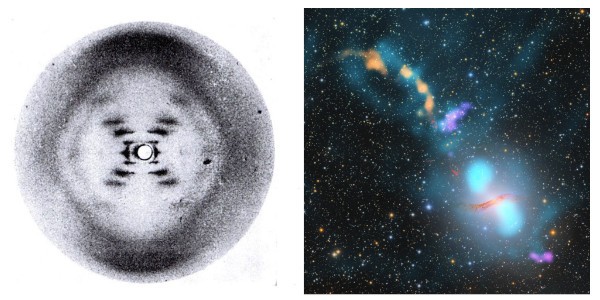The art of science: Exploring the images behind the latest research
When you think of scientific images, you may think of graphs or maps and neatly laid out figures – but what about the other side of scientific imagery?
Scientific research can produce truly breath-taking images – from the first X-ray diffraction patterns of DNA (below, left) to radio images of neighbouring galaxies (below, right). And whilst pictures and images like these are visually appealing, they also showcase some amazing advancements in science.

Here at P站视频, our Communities and Engagement team have a front row view of some amazing images from the latest research shared through the . Whether it be never-before-seen images of research, a behind the scenes view of the scientific process, or drawings created by authors themselves, these images can bring science to life in new ways that continue to amaze us! Here, we wanted to share and celebrate some of these recent, remarkable images.
Bringing new protocols to life
Showcasing simulations
As well as images and videos, simulations can also be leveraged to share the latest research in eye-catching ways. Philip Loche, a post-doctoral researcher from ?cole Polytechnique Fédérale de Lausanne, did just that - sharing a number of videos with the , showing computer simulations used to study the evaporation energetics and kinetics of a chloride ion from liquid water.
 Illustrating new solutions to tackle existing challenges
Illustrating new solutions to tackle existing challenges
Cultured or lab-grown meat is an emerging technology that is increasingly being discussed as a potentially sustainable solution to the environmental, ethical, and health impacts of animal-based agriculture. Growing cells in the lab has the potential to address these issues but, to date, studies have relied on the use of certain animal-derived products. Andrew Stout, a PhD candidate at Tufts University, shared of bovine cells to illustrate research carried out to create a new type of animal-component-free media to aid the field’s progress.
 Showing another side of volcanoes
Showing another side of volcanoes
shows a number of radiolarian fossils’ from Eastern Australia. Radiolarians are single-celled and soft-bodied organisms that absorb silica from seawater to form elaborate skeletal structures, and these particular fossils are over 300 million years old. Goran Andjic from Utrecht University shared this striking image with the to highlight how geochronology can be used use to estimate the age of volcanic rocks.
Shedding light on long-held theories
As well as exploring the stories behind the latest research across the , we regularly share beautiful images through the account. Visit the Nature Portfolio on Instagram and follow along to see the latest images updates from research teams around the world.
About the Author

Sorrel Bunting is Head of Communities and Engagement at P站视频, and is based in London. Her main focus is providing opportunities for researchers to engage and share their work with different audiences, including through the Nature Portfolio and P站视频 Communities.





Why the Social Sciences matter now more than ever
Reflections from 10 authors